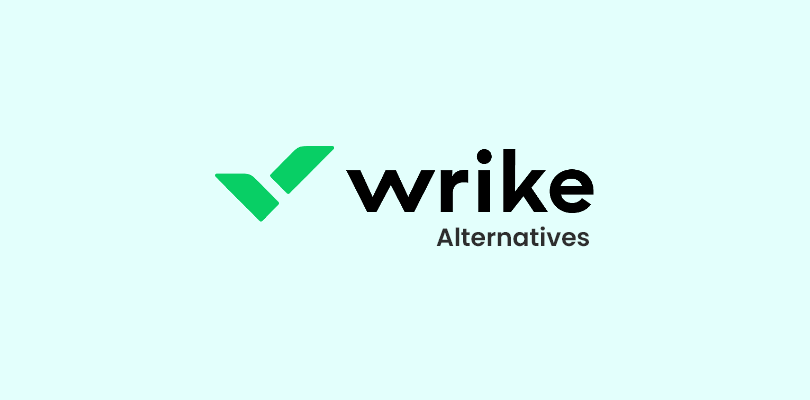
Wrike has been a popular name in the project management industry for years, and for good reason. But it may not be the best solution for every business owing to its difficult-to-navigate interface and expensive pricing.
So, if you want to explore and know more about some of the best Wrike alternatives, then you’re probably at the best place!
In this blog, I’ll compare 10 top-rated Wrike competitors that not only simplify the project management process but also bring better value for your investment.
10 Best Wrike Alternatives in 2024
Over the last few months, I’ve gathered thoughts from industry experts, peers, past colleagues, and client testimonials from software review sites. On top of that, I’ve used my personal experience with project management solutions to provide you with a well-researched evaluation to help you make an informed decision.
1. ProProfs Project – Best for Simplified Project Management

ProProfs Project is a simple cloud-based project management software with a range of features that make it one of the best alternatives to Wrike. I’ve had the chance to test it without any limitations whatsoever – thanks to the free trial.
With ProProfs Project, you can set due dates, track progress, prioritize projects, and collaborate with your team in real time. It has a simple user interface. And I think that makes it a perfect choice for startups and SMBs.
The software offers multiple project progress views – including a calendar, Gantt chart, Kanban board, and list. It also offers advanced features like time tracking, invoicing, and resource management – ensuring that you have complete control over your projects.
What you’ll like:
- Automates time-consuming tasks to streamline workflow and boost efficiency
- Effortless file-sharing with team members, stakeholders, and clients – ensuring everyone is on the same page
- Enables you to make informed decisions based on insightful reports and analytics
- Lets you adjust workflows with quick drag-and-drop actions, adapting to changing project needs
- The ability to manage multiple projects effectively with comprehensive portfolio management capabilities
What you may not like:
- The free trial period might seem short to explore the software in depth
- The software could bring in some more native integration options
Pricing: Starts at $39.97/month. A 15-day free trial is available.
2. Smartsheet – Best for Real-Time Project Collaboration
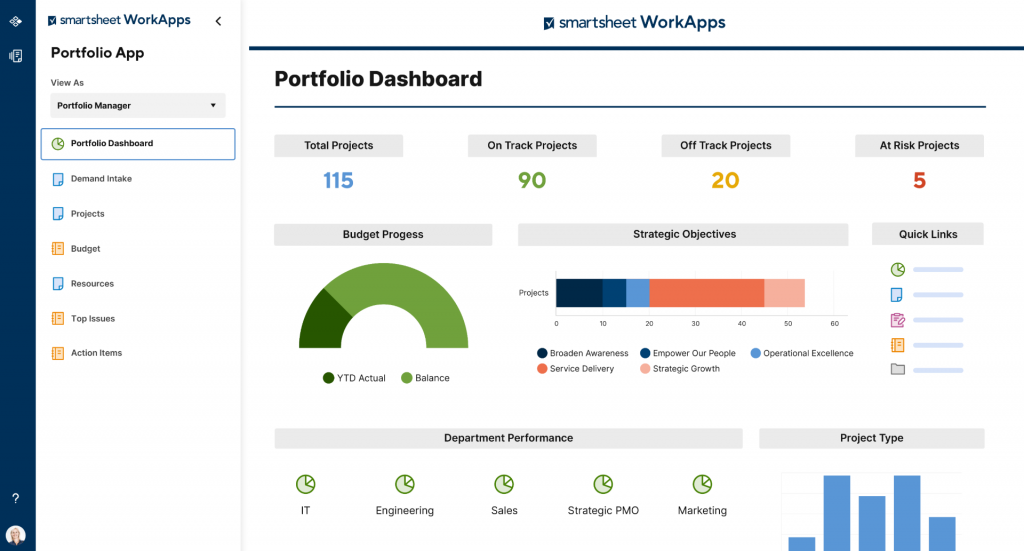
(Image Source: Smartsheet)
Next is Smartsheet, which is quite similar to Wrike when it comes to project management. The platform allows your team members to work together on projects in real time from anywhere. This feature is extremely handy for remote teams.
In addition to real-time collaboration, the software also offers a range of other features, including customizable templates, Gantt charts, automated workflows, etc.
I also found the platform’s drag-and-drop interface pretty sound. It’s easy to manage tasks, and you can assign tasks to specific team members, ensuring that everyone is on the same page.
What you’ll like:
- Consolidates project information, tasks, and communication in a single, accessible location
- Workflow automation triggers actions based on specific events, such as sending notifications, updating task statuses, etc.
- Flexible views, such as Gantt charts, Kanban boards, and calendars, to visualize project information in the simplest way
- Real-time collaboration features that enable team members to view updates, make comments, and share files
- Customizable dashboards provide an overview of project status to empower teams to make decisions quickly
What you won’t like:
- Some users reported having difficulty in retrieving deleted items, which can be an issue at times
- The free plan limits access to users for publishing sheets, dashboards, etc.
Pricing: A free plan is available with limited sheets to track projects and tasks. Paid options start at $7/user/month.
3. Trello – Best for Project Workflow Automation
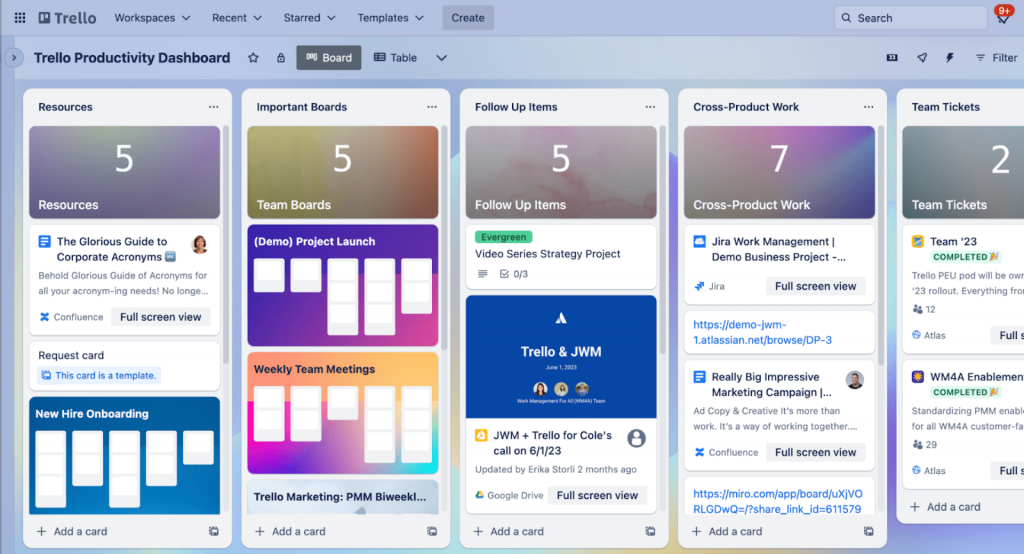
(Image Source: Trello)
Trello is an excellent alternative to Wrike that lets you automate project workflows to manage repetitive tasks.
With Trello’s automation, you have the ability to create rules that instantly run a set of actions when triggered by a defined action. It has a simple native language system that requires no coding, so you can set up any automation in seconds.
It also lets you create boards, lists, cards, etc., to organize tasks and collaborate with team members.
For example, you can create a rule that moves a card to the top of the list, notifies the board – “Can someone take this?” and sets an immediate due date when a card is labeled “urgent.”
What you’ll like:
- Uses a Kanban-style board system to visualize project workflows, making it easy to see task status
- Cards represent tasks, where you can add due dates, attachments, etc., and assign them to team members
- Customizable boards, where you can add lists and labels and rearrange them with a drag and drop interface
- Integrates with communication tools like Slack, facilitating seamless communication within teams
- Add-ons to extend the functionality from calendar integration to time tracking
What you may not like:
- The free plan might not be a great option as it restricts multiple project views, custom fields, etc.
- There is a lack of built-in support for handling task dependencies
Pricing: A free plan is available with limitations to project views like map, calendar, timeline, etc. Paid options start at $5/user/month.
4. Jira Software – Best for Tracking Project Issues
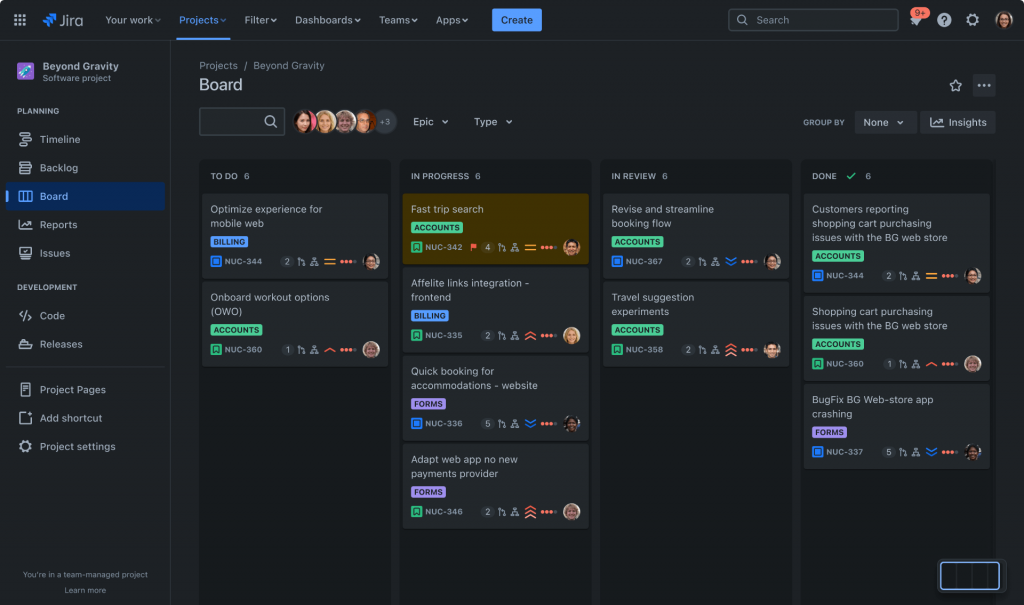
(Image Source: Atlassian)
Jira is an exceptional Wrike alternative for tracking project issues. Whether it’s tracking bugs, monitoring tasks, or resolving roadblocks, with Jira, you can always keep your project on track.
You can effectively capture, categorize, and prioritize issues – keeping your team focused on the most critical tasks. I also found it has customizable fields that allow you to tailor the issue-tracking process to specific needs.
With the software’s real-time updates, you can keep everyone on your team informed of the latest developments.
I think the tool’s flexible structure paves the way to customize workflows, add users, and integrate with third-party tools – ensuring the project management system grows with your organization.
What you’ll like:
- The ability to break down projects into manageable tasks, user stories, and issues
- Transparent task tracking for complete visibility and prioritizing teamwork
- Data-driven performance optimization to identify areas for improvement and enhance team performance
- Ready-made templates for various project management methodologies, making it easy for teams to get started quickly
- Automation capabilities to save time and keep the team focused on more important work
What you may not like:
- 2 GB of file storage space in the free plan is limiting for most teams
- A steeper learning curve, particularly for non-technical teams
Pricing: A free plan is available for limited users. Paid options start from $8.15/user/month.
5. Asana – Best for Real-Time Insights
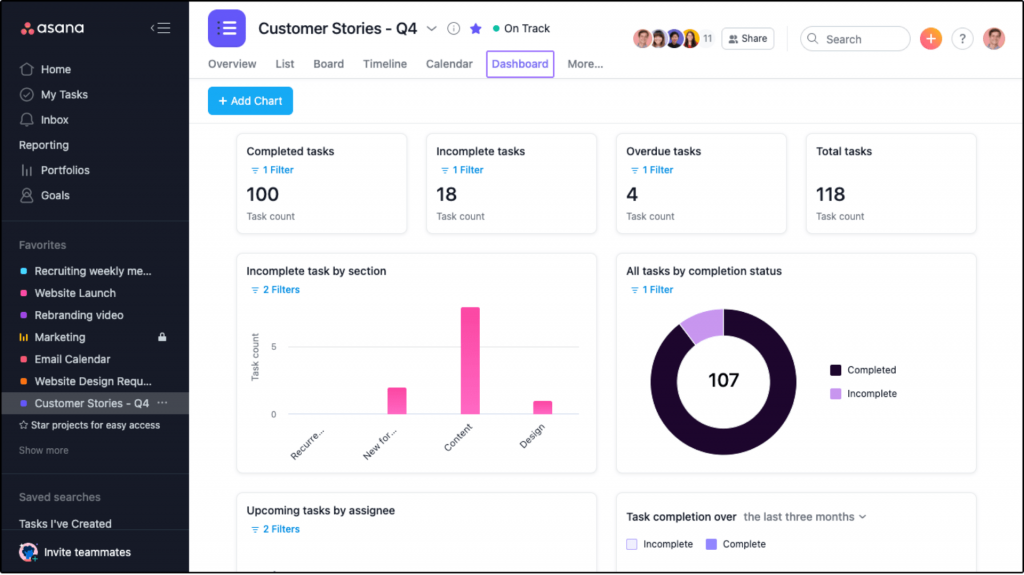
(Image Source: Asana)
Asana is another robust project management platform that stands tall as a worthy alternative to Wrike.
A close peer of mine uses the software, and from what I saw – it does all the basic things, like letting you create projects, assign tasks, set deadlines, and collaborate with your team.
The software gives you real-time insights, with a clear overview of project progress, task deadlines, etc. You can see how your team is doing, what’s due, and what needs attention. In my opinion, this level of visibility is crucial to keep projects on track and minimize miscommunication and delays.
Asana’s custom workflows add a layer of flexibility, enabling you to tailor the platform to your unique team dynamics and project requirements.
What you’ll like:
- Gives a clear overview of your project’s progress with real-time dashboards and reports
- Customizable workflows to adapt Asana to your specific team dynamics and project requirements
- Breaks down complex projects into manageable tasks to track progress and monitor team performance
- Allows you to add labels to tasks, providing the ability to sort, filter, and generate automated reports
- Lets you automate repetitive tasks, such as sending reminders or updating project status
What you may not like:
- The free plan misses out on several key features like Gantt charts, custom fields, time tracking, etc.
- Switching between multiple project views is not that flexible
Pricing: A free plan is available with limitations to task templates, dependencies, etc. Paid options start at $10.99/user/month.
6. ClickUp – Best for Project Tracking & Organizing
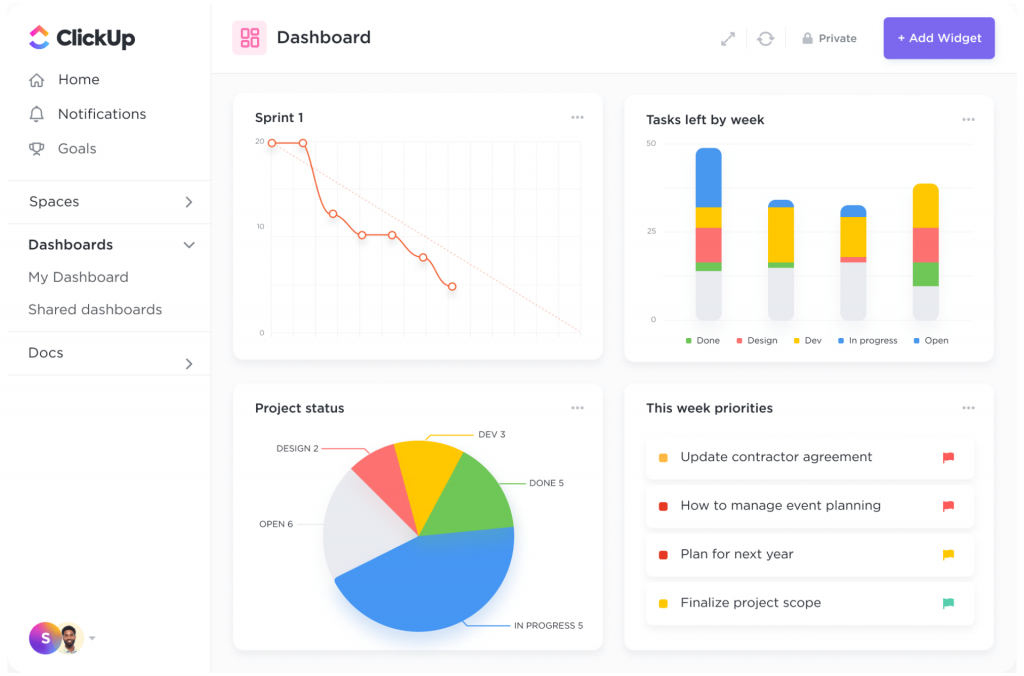
(Image Source: ClickUp)
Next on the list, I have ClickUp, another project management software that can be used as an alternative for Wrike.
With ClickUp, you can easily track and organize projects in one place – making it effortless for everyone on the team to collaborate. The platform has customizable views that allow you to manage work in a list, Gantt chart, or dashboard format.
You can also assign comments with action items, chat in real time, and share attachments, further easing team collaboration. The software also lets you add visual widgets for team members, tasks, sprints, time tracking, statuses, docs, embeds, and more to track progress.
What you’ll like:
- Organizes tasks into subtasks, folders, and lists to create a manageable hierarchy for complex projects
- A library of customizable pre-built templates to standardize project workflows
- Lets you set goals and track progress by creating manageable milestones
- Enables you to track time spent on tasks and generate detailed reports to improve productivity and resource allocation
- Prioritizes data security with two-factor authentication, role-based access control, and data encryption
What you may not like:
- Only 100 MB of storage space in the free plan is impractical for most businesses
- Some users have reported experiencing delays when adding new tickets/cards to boards
Pricing: A free plan is available with limited storage space. Paid options start at $7/member/month.
7. Basecamp – Best for Remote Work Collaboration
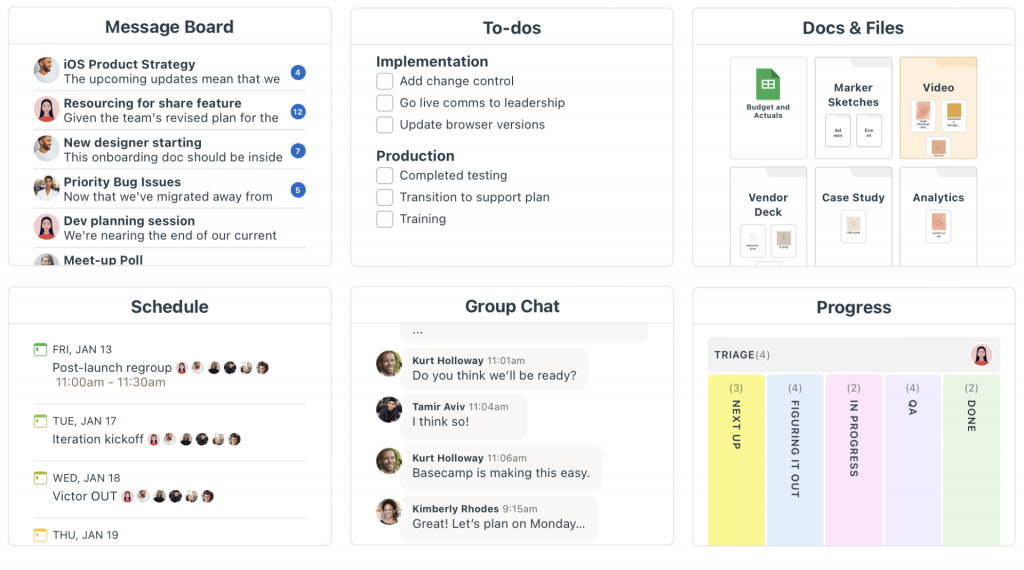
(Image Source: Basecamp)
As someone who works remotely, I appreciate Basecamp’s focus on remote work collaboration. The software makes it easy to stay connected with your team no matter where you are.
It offers multiple features that make it easy to collaborate with team members, including message boards, real-time group chat, and automatic check-ins.
Basecamp’s unique take on Kanban with its card table makes it easy to track progress. I found something it calls Hill charts – which provide a visual representation of where projects stand. Plus, the ability to consolidate billing and simplify onboarding makes working with the software a no-brainer.
What you’ll like:
- A centralized hub for project organization to eliminate the chaos of disjointed communication channels, cluttered folders, etc.
- File sharing and collaborative writing tools ensure that the team is working with up-to-date information
- Lets you invite clients or external stakeholders to facilitate their involvement in projects
- Built-in time tracking feature to track time spent on tasks and monitor project progress
- Unlike many project management tools that charge per user, Basecamp supports unlimited users for all plans
What you won’t like:
- The software may not be ideal for complex or large-scale projects that require extensive project tracking
- Basecamp does not support custom statuses for each task
Pricing: Starts at $15/user/month.
8. Zoho Projects – Best for Task Automation
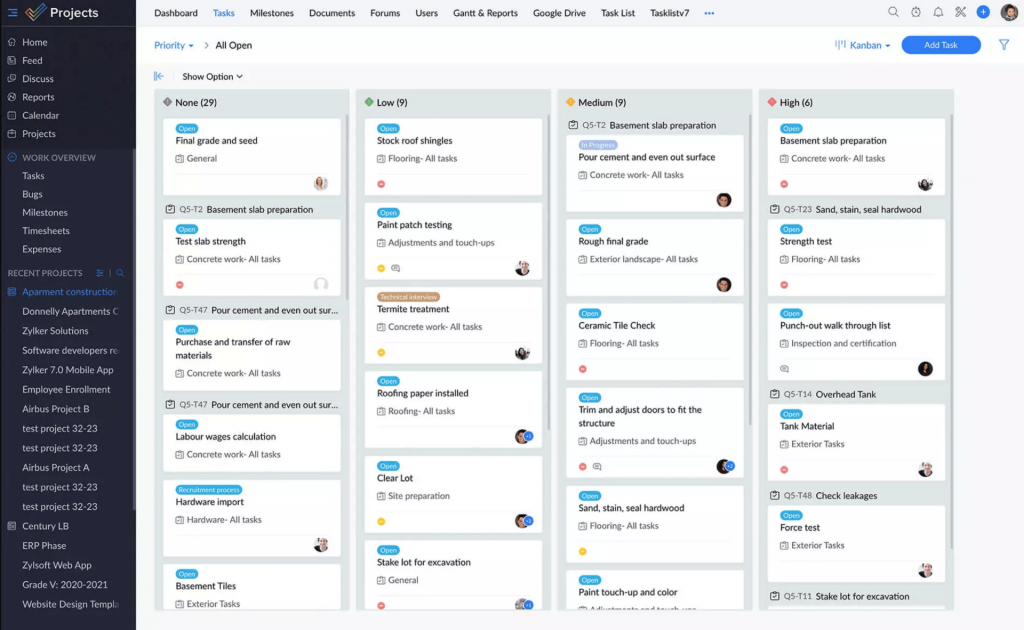
(Image Source: Zoho Projects)
Zoho Projects, my next pick for the best Wrike alternatives, is a reliable project management companion. What you may instantly like is its task automation capabilities.
With the help of its blueprint editor, you can easily automate routine task processes by designing workflows. The tool lets you set up task statuses, loop in the right people, and automate task field updating and email alerts.
This ensures that the right process is followed and project delays are reduced.
I liked the software’s extensive task management features like a detailed hierarchy, four types of dependency, a Kanban, and a calendar view.
Zoho Projects also excels in providing real-time visibility into project progress. With its comprehensive reporting tools, it’s pretty simple to monitor team performance and identify potential roadblocks.
What you’ll like:
- Offers many features, including task management, time tracking, reporting, project planning, etc.
- Has a bug tracker to help organize and resolve any issues during the project
- Lets you add custom fields and layouts to tasks, issues, and bugs
- A Kanban view that allows you to visualize tasks as cards in columns
- Integrates with other Zoho products, such as Zoho Desk, for helpdesk support
What you may not like:
- 5 GB of storage space in the free plan is inadequate for most teams
- The initial setup and customization process can take a lot of time
Pricing: A free plan is available for only up to 2 projects. Paid options start at $4/user/month.
9. monday.com – Best for Resource Management
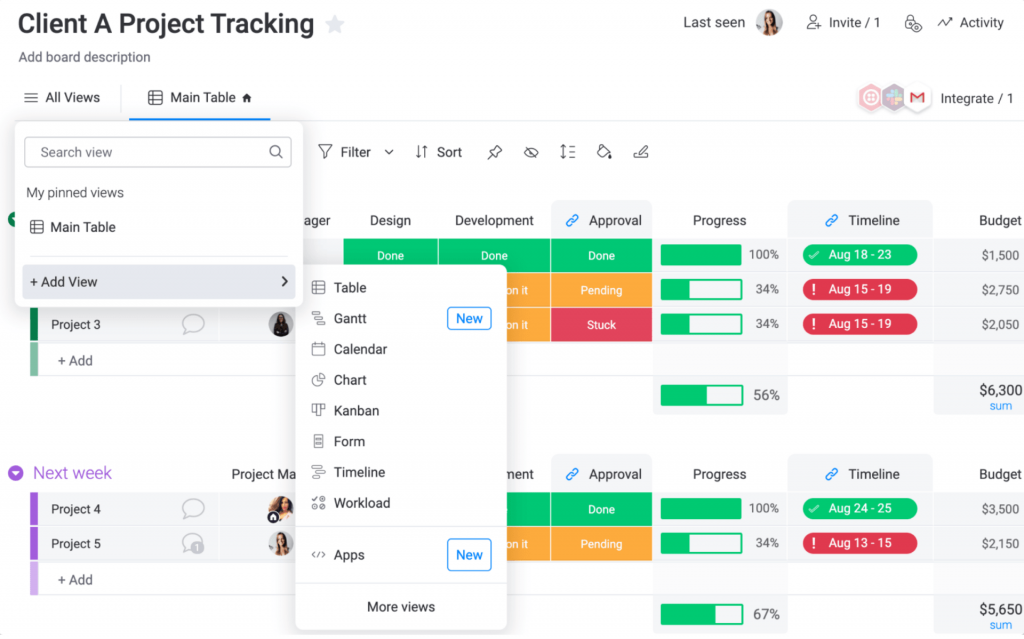
(Image Source: monday.com)
If you’re looking for alternatives to Wrike that bring the best of resource management, I think monday.com can be a good choice.
The tool allows you to plan the use of resources and schedule their allocation. This includes anything your business needs to operate effectively, such as employees, equipment, or even brand assets.
With monday.com, you can easily see who is working on what, how much time each task takes, and when each deadline is due.
In my opinion, visualizing each team member’s workload makes it easy to proactively adjust schedules to ensure everyone is working at their peak performance. This not only improves project efficiency but also boosts team morale and productivity.
What you’ll like:
- Visual boards and customizable dashboards to track project progress, identify dependencies, and collaborate with the team
- Multiple project management methodologies, such as Agile, Kanban, and Waterfall
- Robust collaboration features, including real-time updates, file sharing, task assignments, etc.
- A library of templates for a variety of projects, industries, and workflows
- Helps you keep track of your project’s finances and ensure that you stay within budget
What you may not like:
- The free plan restricts key features like integration support, automation capabilities, etc.
- It may not be the best choice for teams that manage very complex projects with a high level of interdependence
Pricing: A free plan is available for only 2 users. Paid options start at $8/seat/month.
10. ProofHub – Best for Time Tracking
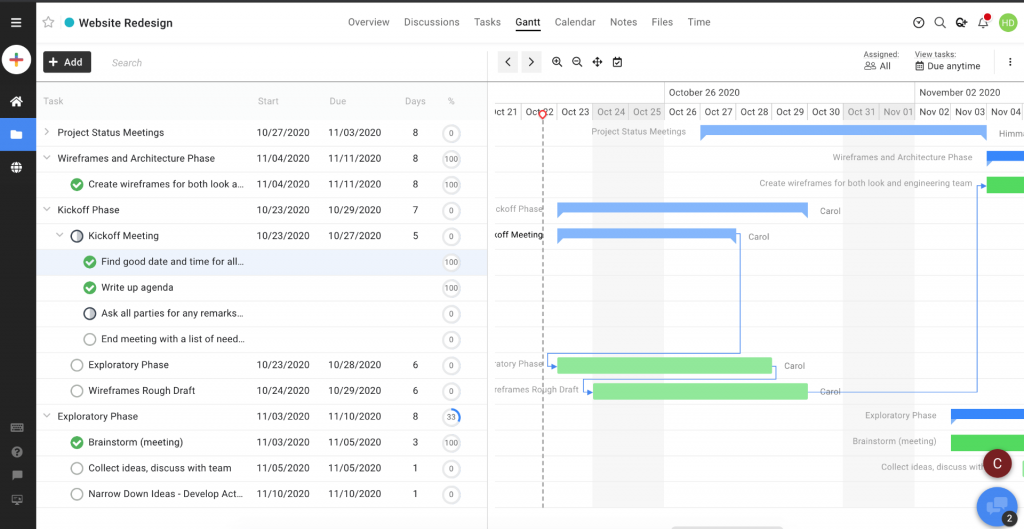
(Image Source: PCMag)
ProofHub is one of the best Wrike alternatives that has some impressive time-tracking capabilities.
With the built-in timer, you can easily track the time team members spend on each task. This not only ensures accurate billing but also provides valuable insights into project progress.
I liked how the tool allows setting time estimates and comparing them to actual time spent. It can be instrumental in identifying areas for improvement and optimizing your workflow.
Beyond time tracking, ProofHub also offers a host of other features like a centralized communication hub, task management capabilities, team collaboration, etc.
What you’ll like:
- Visualizes project timelines, task dependencies, and project progress with Gantt charts
- Lets you assign custom roles to team members and control their access permissions
- File and document sharing with team members and clients for real-time collaboration
- Project templates can be customized and reused, saving time when creating similar projects in the future
- Allows you to create personalized dashboards that provide quick access to the most important project information
What you may not like:
- Some users have encountered occasional UI glitches that can hinder productivity
- The starter plan does not allow access to features like project workflows, reports, custom roles, etc.
Pricing: Starts at $45/month.
Evaluation Criteria
The evaluation of products or tools chosen for this article follows an unbiased, systematic approach that ensures a fair, insightful, and well-rounded review. This method employs six key factors:
- User Reviews / Ratings: Direct experiences from users, including ratings and feedback from reputable sites, provide a ground-level perspective. This feedback is critical in understanding overall satisfaction and potential problems.
- Essential Features & Functionality: The value of a product is ascertained by its core features and overall functionality. Through an in-depth exploration of these aspects, the practical usefulness and effectiveness of the tools are carefully evaluated.
- Ease of Use: The user-friendliness of a product or service is assessed, focusing on the design, interface, and navigation. This ensures a positive experience for users of all levels of expertise.
- Customer Support: The quality of customer support is examined, taking into account its efficiency and how well it supports users in different phases – setting up, addressing concerns, and resolving operational issues.
- Value for Money: Value for money is evaluated by comparing the quality, performance, and features. The goal is to help the reader understand whether they would be getting their money’s worth.
- Personal Experience / Expert’s Opinion or Favorites: This part of the evaluation criteria draws insightful observations from the personal experience of the writer and the opinions of industry experts.
Which Is the Best Wrike Alternative for You?
Figuring out which of these Wrike alternatives is the best choice for you requires a bit of understanding of your company’s requirements, such as your team size and the features you need.
In my opinion, the top 3 software options that tick most boxes if you just want a simple and reliable project management tool are –
Option A: ProProfs Project
ProProfs Project is a simple cloud-based project management software that lets you plan, track, and collaborate on projects. It has an intuitive user interface, offers multiple project progress views, and advanced features like time tracking, invoicing, and resource management. It is a great choice for startups and SMBs looking for clutter-free alternatives to Wrike.
Option B: Basecamp
Basecamp is one of the highly recommended project management tools like Wrike for remote work collaboration. Its features include message boards, real-time group chat, and a unique take on Kanban with its card table and Hill charts. Consolidated billing and simplified onboarding make it a great alternative to Wrike.
Option C: ProofHub
ProofHub is one of the tools similar to Wrike with impressive time-tracking capabilities. It has a built-in timer that allows accurate billing and provides insights into project progress. In addition, it enables setting time estimates, identifying areas for improvement, and optimizing workflows. It offers other features like a centralized communication hub, task management capabilities, team collaboration, etc.
Regardless of which software you find the right fit for your company, never forget to redeem the free trial period or use the free plan to get a first-hand experience of the functionalities offered.
FREE. All Features. FOREVER!
Try our Forever FREE account with all premium features!





